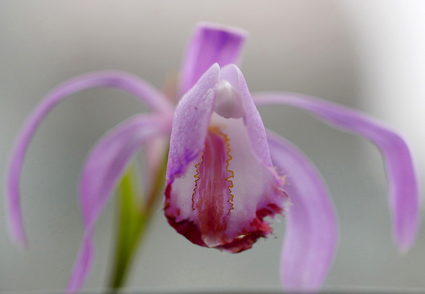Abstract
Pleione xiushanensis, a new orchid plant from the Mt. Wulingshan Region of China, is illustrated and described based on morphological comparisons and phylogenetic analyses. The species is similar to P. bulbocodioides and P. pleionoides but differs from the former in that its lip lacks central lamellae and from the latter in that its lip exhibits fuchsia punctata. Additionally, the lip of P. bulbocodioides and P. pleionoides has 2 or 4 denticulate lamellae, but the lip of the new species has 2 internal integer lamellae and 2 external denticulate lamellae. Our phylogenomic evidence based on the nrITS sequence resolved P. xiushanensis as sister to P. jinhuana. P. jinhuana has 2 denticulate lamellae and shows margin erosion at the apical edge of the lip, but P. xiushanensis has 4 denticulate lamellae and shows no margin erosion of the lip.
References
- Braem, G.J. & Mohr, H. (1989) Pleione pinkepankii and Pleione pleionoides, two new taxa of Asiatic terrestrial orchids. Orchis 121-126.
- Chen, G.X.; Liao, W.B. & Zhang, H.D. (2001) Characteristics of Spermatophyte Flora of Mt. Wulingshan Region from Central China and Its Phytogeographical Significance. Acta Scientiarum Naturalium Universitatis Sunyatseni 40: 74–78.
- Chen, G.X., Liu, S.B., Ao, C.Q. & Liao, W.B. (2004) On endemic genera to China of spermatophytic flora from Mt. Wulingshan Region. Acta Botanica Boreali-Occidentalia Sinica 24: 865–871.
- Chen, X., Cribb, P.J. & Gale, S.W. (2009) Pleione. In: Wu, Z.Y., Raven, P.H. & Hong, D.Y. (Eds.) Flora of China 25 (Orchidaceae). Science Press, Beijing, and Missouri Botanical Garden Press, St. Louis, pp. 325–333.
- Cribb, P. & Butterfield, I. (1999) The genus Pleione, second edition. Royal Botanic Gardens, Kew, 27 pp.
- Gravendeel, B., Eurlings, M.C.M., van den Berg, C. & Cribb, P.J. (2004) Phylogeny of Pleione (Orchidaceae) and parentage analysis of its wild hybrids based on plastid and nuclear ribosomal its sequences and morphological data. Systematic Botany 29: 50–63. https://doi.org/10.1600/036364404772973988
- Hareesh,V.S., Kumar, P. & Sabu, M. (2017) Pleione arunachalensis (Orchidaceae: Epidendroideae: Arethuseae: Coelogyninae), a new species from North-East India. Phytotaxa 291: 294–298. https://doi.org/10.11646/phytotaxa.291.4.7
- Jiang, M.T., Wu, S.S., Liu, Z.J. & LAN, S.R. (2018) Pleione jinhuana (Arethuseae; Epidendroideae; Orchidaceae), a new species from China based on morphological and DNA evidence. Phytotaxa 345: 43–50. https://doi.org/10.11646/phytotaxa.345.1.5
- Kalyaanamoorthy, S., Minh, B., Wong, T., Haeseler, A. & Jermiin, L. (2017) ModelFinder: fast model selection for accurate phylogenetic estimates. Nature Methods 14: 587–589. https://doi.org/10.1038/nmeth.4285
- Li, M.H., Gruss, Q. & Liu, Z.J. (2016) Nomenclature changes in Phalaenopsis subgen.Hygrochilus (Orchidaceae; Epidendroideae; Vandeae) based on DNA evidence. Phytotaxa 275: 55–61. https://doi.org/10.11646/phytotaxa.275.1.6.
- Pfitzer, E. & Kraenzlin, F. (1970) Pleione D. Don. Das Pflanzenreich 32: 119–129.
- Rolfe, R.A. (1903) The genus Pleione. The Orchid Review 11: 289–292.
- Taberlet, P., Gielly, L., Pautou, G. & Bouvet, J. (1991) Universal primers for amplification of three non-coding regions of chloroplast DNA. Plant Molecular Biology 17: 1105–1109. https://doi.org/10.1007/BF00037152.
- Torelli, G. & Riccaboni, M. (1998) Proposta di una nuova classificazione infragnerica del genero Pleione (Orchidaceae). Caesiana 10: 1–6.
- Torelli, G. (2000) The genus Pleione. Italian Journal of Orchidology 14: 1–147.
- Xiang, Z.Y., Kong, J.J., Hua, M., Zhao, L.M., Zhang, W.P., Fang, Y., Hai, X., Fang, Z.D., Han, Z.D. & Jiang, H. (2019) An Additional Note on Two Species of Pleione (Orchidaceae) from China. Journal of Tropical and Subtropical Botany 27: 461–464.
- Zhang, G.Q., Liu, K.W., Chen, L.J., Xiao, X.J., Zhai, J.W., Li, L.Q., Cai, J., Hsiao, Y.Y., Rao, W.H., Huang, J., Ma, X.Y., Chung, S.W., Huang, L.Q., Tsai, W.C. & Liu, Z.J. (2013) A new molecular phylogeny and a new genus, Pendulorchis, of the Aerides-Vanda alliance (Orchidaceae: Epidendroideae). PLoS ONE 8: e60097. https://doi.org/10.1371/journal.pone.0060097
- Zhang, W., Qin, J., Yang, R., Yang, Y. & Zhao, S.B. (2018) Two new natural hybrids in the genus Pleione (Orchidaceae) from China. Phytotaxa 350: 247–258. https://doi.org/10.11646/phytotaxa.350.3.4
- Zhang, D., Gao, F.L., Jakovlić, I., Zou, H., Zhang, J., Li, W.X. & Wang, GT. (2020) PhyloSuite: an integrated and scalable desktop platform for streamlined molecular sequence data management and evolutionary phylogenetics studies. Molecular Ecology Resources 20: 348–355. https://doi.org/10.1111/1755-0998.13096
- Zhu, G.H. & Chen, X.Q. (1998) Humiles, a New Section of Pleione (Orchidaceae). Novon 8: 461–63.


